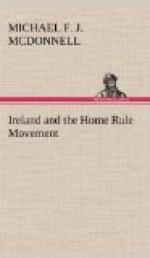After the famine, when it was found that one-third of the Irish landlords were bankrupt, the Encumbered Estates Court Act was passed to cope with the situation which had arisen of a country full of numerous landlords saddled with land which, owing to mortgages, debts, and incumbrances, was inalienable. Under the Act the Court was empowered, on the petition of any person sufficiently interested, to sell the encumbered estate and give an indefeasible title, so that persons who before had a claim on the estate should now have a claim only on the purchase-money. It was a piece of strong legislation in its disregard of vested rights and in the manner in which it set aside express contracts under which creditors had a claim on the land which could only be disturbed by paying off that claim.
In the event the rush of creditors to this Court—created to afford relief from the delays of Chancery in effecting alienation—was so great that, as a result of the consequent fall in prices, land became a drug in the market, and properties in many instances did not realise enough to meet the mortgages. To the landlords ruined in this manner succeeded a new class, who bought up bankrupt estates, often with borrowed money, as a commercial speculation, and caring nothing for the tenant or his welfare, looking only on the business side of the transaction, raised rents arbitrarily to such a pitch that the tenantry were unable to meet their liabilities. Wholesale evictions ensued, and in this wise arose the condition of things in which the Times—never an unfriendly critic of the landed interest—was constrained to admit in 1852 that “the name of an Irish landlord stinks in the nostrils of Christendom.”
By an Act of 1858 the Encumbered Estates Court was replaced by the Landed Estates Court, which had power to carry out the sale of, and give an indefeasible title to, any interests in land, whether hypothecated or not, and after the passing of the Judicature Act of 1877 the name of the Court became the Land Judges’ Court.
The disfranchising clauses of the Emancipation Act, and the consequent disappearance of the advantages accruing to the landlords from a multiplication of holdings on their estates, the miserable poverty resulting from the famine, the anxiety of the proprietors to escape the burdens of the remodeled Poor Law, and the demand by the new class of land speculators for large grazing or tillage farms, to form which the consolidation of existing holdings was demanded, were the factors which resulted in the clearances of 1849 and the subsequent years. “Notices to quit,” in a historic phrase, “fell like snowflakes,” at a time when it was truly said that an eviction was equal to a sentence of death. In a few months whole counties, such as those of Meath and Tipperary, were converted into prairies; cabins were thrown down, fences removed, and peasants swept off, and in ten years nearly 300,000 families were evicted from their homes, and a million and a half of the population fled across the Atlantic. “I do not think,” said Sir Robert Peel—and his verdict has been endorsed by the judgment of history—“I do not think that any country, civilised or uncivilised, can offer similar scenes of horror.”




